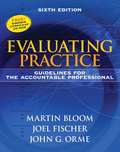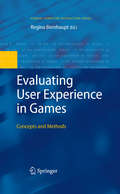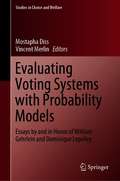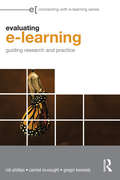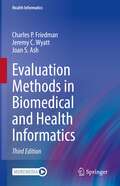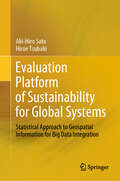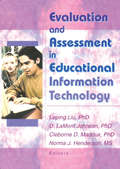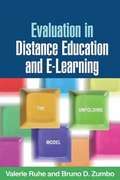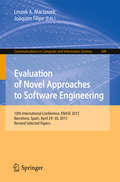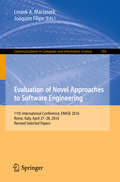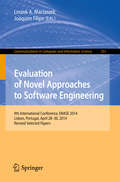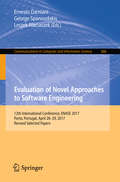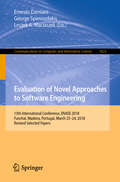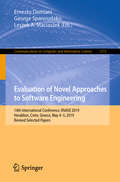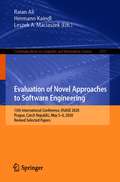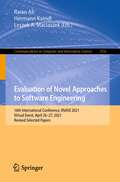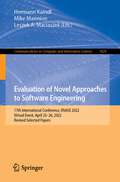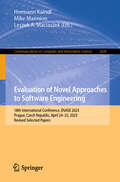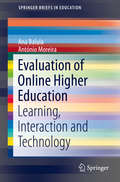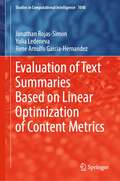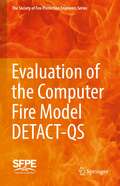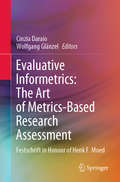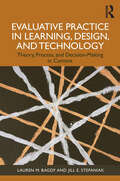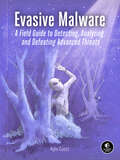- Table View
- List View
Evaluating Practice: Guidelines for the Accountable Professional
by Martin Bloom Joel Fischer John G. OrmeFocusing on single-system designs, Evaluating Practice, 6/e presents clear guidelines on conceptualizing and measuring problems, developing practice-oriented evaluation designs, understanding and analyzing data, and ethical guidelines for practice evaluation.
Evaluating User Experience in Games
by Regina BernhauptUser Experience has become a major research area in human-computer interaction. The area of game design and development has been focusing on user experience evaluation for the last 20 years, although a clear definition of user experience is still to be established. The contributors to this volume explore concepts that enhance the overall user experience in games such as fun, playability, flow, immersion and many others. Presenting an overview of current practice from academia and industry in game development, the book shows a variety of methods that can be used to evaluate user experience in games, not only during game-play but also before and after the game play. Evaluating User Experiences in Games: Presents a broad range of user experience evaluation methods and concepts; Provides insights on when to apply the various user experience evaluation methods in the development cycle and shows how methods can be also applied to a more general HCI context; Includes new research on evaluating user experience during game play and after; and social play; Describes new evaluation methods; Details methods that are also applicable for exertion games or tabletop games. This comprehensive book will be welcomed by researchers and practitioners in the field.
Evaluating Voting Systems with Probability Models: Essays by and in Honor of William Gehrlein and Dominique Lepelley (Studies in Choice and Welfare)
by Mostapha Diss Vincent MerlinThis book includes up-to-date contributions in the broadly defined area of probabilistic analysis of voting rules and decision mechanisms. Featuring papers from all fields of social choice and game theory, it presents probability arguments to allow readers to gain a better understanding of the properties of decision rules and of the functioning of modern democracies. In particular, it focuses on the legacy of William Gehrlein and Dominique Lepelley, two prominent scholars who have made important contributions to this field over the last fifty years. It covers a range of topics, including (but not limited to) computational and technical aspects of probability approaches, evaluation of the likelihood of voting paradoxes, power indices, empirical evaluations of voting rules, models of voters’ behavior, and strategic voting. The book gathers articles written in honor of Gehrlein and Lepelley along with original works written by the two scholars themselves.
Evaluating e-Learning: Guiding Research and Practice (Connecting with E-learning)
by Rob Phillips Carmel McNaught Gregor KennedyHow can novice e-learning researchers and postgraduate learners develop rigorous plans to study the effectiveness of technology-enhanced learning environments? How can practitioners gather and portray evidence of the impact of e-learning? How can the average educator who teaches online, without experience in evaluating emerging technologies, build on what is successful and modify what is not? By unpacking the e-learning lifecycle and focusing on learning, not technology, Evaluating e-Learning attempts to resolve some of the complexity inherent in evaluating the effectiveness of e-learning. The book presents practical advice in the form of an evaluation framework and a scaffolded approach to an e-learning research study, using divide-and-conquer techniques to reduce complexity in both design and delivery. It adapts and builds on familiar research methodology to offer a robust and accessible approach that can ensure effective evaluation of a wide range of innovative initiatives, including those covered in other books in the Connecting with e-Learning series. Readers will find this jargon-free guide is a must-have resource that provides the proper tools for evaluating e-learning practices with ease.
Evaluation Methods in Biomedical and Health Informatics (Health Informatics)
by Joan S. Ash Charles P. Friedman Jeremy C. WyattHeavily updated and revised from the successful first edition Appeals to a wide range of informatics professionals, from students to on-site medical information system administrators Includes case studies and real world system evaluations References and self-tests for feedback and motivation after each chapter Great for teaching purposes, the book is recommended for courses offered at universities such as Columbia University Precise definition and use of terms
Evaluation Platform of Sustainability for Global Systems: Statistical Approach to Geospatial Information for Big Data Integration
by Aki-Hiro Sato Hiroe TsubakiThe authors of this book assert that Grid Square statistics, a method of aggregating data within a geographically defined Grid, may be an effective solution to approach geospatial data for big data integration. Grid Square statistics is a technique that allows us to collect and analyze data based on Grids and makes it easier to understand patterns and trends. Sustainability, a key concern for the future of our society, often involves balancing multiple independent objectives. These objectives and key performance indicators must be shared to solve multi-dimensional optimization problems with some constraints related to sustainability issues. However, many of these sustainability issues are challenges that are part of global systems, which are modeled as a complex system consisting of many components. Social, economic, and environmental aspects in our socio-economic systems require solutions designed for the sustainability of our society. These conditions imply that Big Data must contribute to evaluating our current situation, actions, and changes to continuously change our behavior and society based on a Plan-Do-Check-Action (PDCA) cycle. The PDCA cycle, also known as the Deming cycle, is a four-step management method used to improve processes and products continuously. We must understand how to construct a platform by using Big Data to do so. Thus, extracting meaningful information from Big Data is crucially important in the advanced information society. This book provides case studies based on Grid Square statistics. It shows their applications to socio-economic and environmental problems such as tourism, where we analyze visitor patterns to optimize resource allocation, SDGs indicator, where we monitor the sustainability of our socio-economic systems, and disaster management, where we face natural disaster to enhance preparedness. Finally, the book proposes a World Grid Square Statistics Reference Architecture for constructing data applications across organizations and domains and reports on design concepts, system architecture, and the implication of a data platform for World Grid Square data and statistics.
Evaluation and Assessment in Educational Information Technology
by Cleborne D Maddux D Lamont Johnson Leping Liu Norma HendersonChoose the right hardware and software for your school!This unique book is the first systematic work on evaluating and assessing educational information technology. Here you?ll find specific strategies, best practices, and techniques to help you choose the educational technology that is most appropriate for your institution. Evaluation and Assessment in Educational Information Technology will show you how to measure the effects of information technology on teaching and learning, help you determine the extent of technological integration into the curriculum that is best for your school, and point you toward the most effective ways to teach students and faculty to use new technology.Evaluation and Assessment in Educational Information Technology presents: a summary of the last ten years of assessment instrument development seven well-validated instruments that gauge attitudes, beliefs, skills, competencies, and technology integration proficiencies two content analysis instruments for analyzing teacher-student interaction patterns in a distance learning setting an examination of the best uses of computerized testing--as opposed to conventional tests, as used in local settings, to meet daily instructional needs, in online delivery programs, in public domain software, and available commercial and shareware options successful pedagogical and assessment strategies for use in online settings a four-dimensional model to assess student learning in instructional technology courses three models for assessing the significance of information technology in education from a teacher?s perspective an incisive look at Michigan?s newly formed Consortium of Outstanding Achievement in Teaching with Technology (COATT) ways to use electronic portfolios for teaching/learning performance assessment and much more!
Evaluation in Distance Education and E-Learning
by Valerie Ruhe Bruno ZumboWith the rapid proliferation of distance education and e-learning courses, the need is growing for a comprehensive, professional approach to evaluating their effectiveness. This indispensable book offers a road map to guide evaluation practice in these innovative learning environments. Providing practical, step-by-step guidelines and tools for conducting evaluation studies including how to deal with stakeholders, develop surveys and interview protocols, collect other scientific evidence, and analyze and blend mixed-methods data the work also features a template for writing high-quality reports. The "unfolding model" developed by the authors draws on Messick's influential assessment framework and applies it to program evaluation. Two case studies of actual programs (a distance learning course and an e-learning course) demonstrate the unfolding model in action.
Evaluation of Novel Approaches to Software Engineering
by Leszek A. Maciaszek Joaquim FilipeThis book contains a collection of thoroughly refereed papers presented at the 5th International Conference on Evaluation of Novel Approaches to Software Engineering, ENASE 2010, held in Athens, Greece, in July 2010. The 19 revised and extended full papers were carefully selected from 70 submissions. They cover a wide range of topics, such as quality and metrics; service and Web engineering; process engineering; patterns, reuse and open source; process improvement; aspect-oriented engineering; and requirements engineering.
Evaluation of Novel Approaches to Software Engineering
by Leszek A. Maciaszek Joaquim FilipeThis book constitutes the thoroughly refereed proceedings of the 8th International Conference on Evaluation of Novel Approaches to Software Engineering, ENASE 2013, held in Angers, France, in July 2013. The 18 full papers presented were carefully reviewed and selected from 46 submissions. The papers reflect a growing effort to increase the dissemination of new results among researchers and professionals related to evaluation of novel approaches to software engineering. By comparing novel approaches with established traditional practices and by evaluating them against software quality criteria, the ENASE conferences advance knowledge and research in software engineering, identify most hopeful trends, and propose new directions for consideration by researchers and practitioners involved in large-scale software development and integration.
Evaluation of Novel Approaches to Software Engineering
by Leszek A. Maciaszek Joaquim FilipeThis book contains a collection of thoroughly refereed papers presented at the 5th International Conference on Evaluation of Novel Approaches to Software Engineering, ENASE 2010, held in Athens, Greece, in July 2010. The 19 revised and extended full papers were carefully selected from 70 submissions. They cover a wide range of topics, such as quality and metrics; service and Web engineering; process engineering; patterns, reuse and open source; process improvement; aspect-oriented engineering; and requirements engineering.
Evaluation of Novel Approaches to Software Engineering: 12th International Conference, ENASE 2017, Porto, Portugal, April 28–29, 2017, Revised Selected Papers (Communications in Computer and Information Science #866)
by Leszek Maciaszek Ernesto Damiani George SpanoudakisThis book constitutes the thoroughly refereed proceedings of the 12th International Conference on Evaluation of Novel Approaches to Software Engineering, ENASE 2017, held in Porto, Portugal, in April 2017.The 12 full papers presented were carefully reviewed and selected from 102 submissions. The mission of ENASE is to be a prime international forum to discuss and publish research findings and IT industry experiences with relation to the evaluation of novel approaches to software engineering. The conference acknowledges necessary changes in systems and software thinking due to contemporary shifts of computing paradigm to e-services, cloud computing, mobile connectivity, business processes, and societal participation.
Evaluation of Novel Approaches to Software Engineering: 13th International Conference, ENASE 2018, Funchal, Madeira, Portugal, March 23–24, 2018, Revised Selected Papers (Communications in Computer and Information Science #1023)
by Leszek A. Maciaszek Ernesto Damiani George SpanoudakisThis book constitutes the refereed proceedings of the 13th International Conference on Evaluation of Novel Approaches to Software Engineering, ENASE 2018, held in Funchal, Madeira, Portugal, in March 2018.The 17 revised full papers and 5 revised short papers presented were carefully reviewed and selected from 95 submissions. The papers are organized in topical sections on service science and business information systems and software engineering.
Evaluation of Novel Approaches to Software Engineering: 14th International Conference, ENASE 2019, Heraklion, Crete, Greece, May 4–5, 2019, Revised Selected Papers (Communications in Computer and Information Science #1172)
by Leszek A. Maciaszek Ernesto Damiani George SpanoudakisThis book constitutes the refereed proceedings of the 14th International Conference on Evaluation of Novel Approaches to Software Engineering, ENASE 2019, held in Heraklion, Crete, Greece, in May 2019.The 19 revised full papers presented were carefully reviewed and selected from 102 submissions. The papers included in this book contribute to the understanding of relevant trends of current research on novel approaches to software engineering for the development and maintenance of systems and applications, specically with relation to: model-driven software engineering, requirements engineering, empirical software engineering, service-oriented software engineering, business process management and engineering, knowledge management and engineering, reverse software engineering, software process improvement, software change and configuration management, software metrics, software patterns and refactoring, application integration, software architecture, cloud computing, and formal methods.
Evaluation of Novel Approaches to Software Engineering: 15th International Conference, ENASE 2020, Prague, Czech Republic, May 5–6, 2020, Revised Selected Papers (Communications in Computer and Information Science #1375)
by Leszek A. Maciaszek Raian Ali Hermann KaindlThis book constitutes selected, revised and extended papers of the 15th International Conference on Evaluation of Novel Approaches to Software Engineering, ENASE 2020, held in virtual format, in May 2020.The 19 revised full papers presented were carefully reviewed and selected from 96 submissions. The papers included in this book contribute to the understanding of relevant trends of current research on novel approaches to software engineering for the development and maintenance of systems and applications, specically with relation to: model-driven software engineering, requirements engineering, empirical software engineering, service-oriented software engineering, business process management and engineering, knowledge management and engineering, reverse software engineering, software process improvement, software change and configuration management, software metrics, software patterns and refactoring, application integration, software architecture, cloud computing, and formal methods.
Evaluation of Novel Approaches to Software Engineering: 16th International Conference, ENASE 2021, Virtual Event, April 26-27, 2021, Revised Selected Papers (Communications in Computer and Information Science #1556)
by Leszek A. Maciaszek Raian Ali Hermann KaindlThe present book includes extended and revised versions of a set of selected papers from the 16th International Conference on Evaluation of Novel Approaches to Software Engineering (ENASE 2021), held as an online event from April 26 to 27, 2021.The 15 revised full papers presented were carefully reviewed and selected from 96 submissions. The papers included in this book contribute to the understanding of relevant trends of current research on novel approaches to software engineering for the development and maintenance of systems and applications, specically with relation to: model-driven software engineering, requirements engineering, empirical software engineering, service-oriented software engineering, business process management and engineering, knowledge management and engineering, reverse software engineering, software process improvement, software change and configuration management, software metrics, software patterns and refactoring, application integration, software architecture, cloud computing, and formal methods.
Evaluation of Novel Approaches to Software Engineering: 17th International Conference, ENASE 2022, Virtual Event, April 25–26, 2022, Revised Selected Papers (Communications in Computer and Information Science #1829)
by Leszek A. Maciaszek Hermann Kaindl Mike MannionThis book constitutes the refereed proceedings of the 17th International Conference on Evaluation of Novel Approaches to Software Engineering, ENASE 2022, held Virtually.The 15 full papers included in this book were carefully reviewed and selected from 109 submissions. They were organized in topical sections as follows: Theory and Practice of Systems and Applications Development; Challenges and Novel Approaches to Systems and Software Engineering (SSE); and Systems and Software Quality.
Evaluation of Novel Approaches to Software Engineering: 18th International Conference, ENASE 2023, Prague, Czech Republic, April 24–25, 2023, Revised Selected Papers (Communications in Computer and Information Science #2028)
by Leszek A. Maciaszek Hermann Kaindl Mike MannionThis book constitutes the refereed post-conference proceedings of the 18th International Conference on Evaluation of Novel Approaches to Software Engineering, ENASE 2023, held in Prague, Czech Republic, during April 24–25, 2023. The 15 revised full papers presented in these proceedings were carefully reviewed and selected from 121 submissions. They contribute to the understanding of relevant trends of current research on Evaluation of Novel Approaches to Software Engineering, including: requirements engineering, artificial intelligence development, natural language processing, autonomous systems, model-driven development, product line engineering, software patterns, software metrics, quality assurance, and process management.
Evaluation of Online Higher Education
by António Moreira Ana BalulaThe work presents a theoretical framework for the evaluation of e-Teaching that aims at positioning the online activities designed and developed by the teacher as to the Learning, Interaction and Technology Dimensions. The theoretical research that underlies the study was developed reflecting current thinking on the promotion of quality of teaching and of the integration of information and communication tools into the curriculum in Higher Education (HE), i. e. , bearing in mind some European guidelines and policies on this subject. This way, an answer was sought to be given to one of the aims put forward in this study, namely to contribute towards the development of a conceptual framework to support research on evaluation of e-teaching in the context of HE. Based on the theoretical research carried out, an evaluation tool (SCAI) was designed, which integrates the two questionnaires developed to collect the teachers' and the students' perceptions regarding the development of e-activities. Consequently, an empirical study was structured and carried out, allowing SCAI tool to be tested and validated in real cases. From the comparison of the theoretical framework established and the analysis of the data obtained, we found that the differences in teaching should be valued and seen as assets by HE institutions rather than annihilated in a globalizing perspective.
Evaluation of Rail Technology: A Practical Human Factors Guide (Human Factors in Road and Rail Transport)
by Jillian Dorrian Anjum Naweed Janette RoseRapid advancements in train control and in-cab technologies provide significant opportunities for rail operators to improve efficiency and enhance their operations. New technologies often provide elegant solutions to existing problems or new capabilities for the operator. However, new technologies may also represent a significant form of risk. Thus, it is important to balance the potential for significant improvement with justifiable concern about how the technology may unpredictably change the nature of the work. If a technology is designed and implemented without considering the substantive human factors concerns, that technology may lead to unintended consequences that can introduce safety issues and disrupt network performance. It is important to note that even a well-designed and beneficial technology may be rejected by the users who see it as a threat to their jobs, status or working conditions. This book discusses the issues surrounding rail technology and introduces a ’toolkit’ of human factors evaluation methods. The toolkit provides a practical and operationally focused set of methods that can be used by managers considering investing in technology, staff charged with implementing a technology, and consultants engaged to assist with the design and evaluation process. This toolkit can help to ensure that new rail technologies are thoughtfully designed, effectively implemented, and well received by users so that the significant investment associated with developing rail technologies is not wasted.
Evaluation of Text Summaries Based on Linear Optimization of Content Metrics (Studies in Computational Intelligence #1048)
by Jonathan Rojas-Simon Yulia Ledeneva Rene Arnulfo Garcia-HernandezThis book provides a comprehensive discussion and new insights about linear optimization of content metrics to improve the automatic Evaluation of Text Summaries (ETS). The reader is first introduced to the background and fundamentals of the ETS. Afterward, state-of-the-art evaluation methods that require or do not require human references are described. Based on how linear optimization has improved other natural language processing tasks, we developed a new methodology based on genetic algorithms that optimize content metrics linearly. Under this optimization, we propose SECO-SEVA as an automatic evaluation metric available for research purposes. Finally, the text finishes with a consideration of directions in which automatic evaluation could be improved in the future. The information provided in this book is self-contained. Therefore, the reader does not require an exhaustive background in this area. Moreover, we consider this book the first one that deals with the ETS in depth.
Evaluation of the Computer Fire Model DETACT-QS (The Society of Fire Protection Engineers Series)
by Society for Fire Protection EngineersThis engineering practice Guide, based on the DETACT-QS program, describes a model for predicting the response time of ceiling-mounted heat detectors/sprinklers and smoke detectors, installed under large unobstructed ceilings, for fires with user-defined, time-dependent heat release rate curves. The Guide provides information on the technical features, theoretical basis, assumptions, limitations, and sensitivities as well as guidance on the use of DETACT-QS. Evaluation is based on comparing predictions from DETACT-QS with results from full-scale fire experiments conducted in compartments with ceiling heights ranging from 2.44 m (8 ft) to 12.2 m (40 ft) and peak fire heat release rates ranging from 150 kW to 3.8 MW. Use of this model with building geometries or fire characteristics other than those used in this evaluation may require further evaluation or testing.
Evaluative Informetrics: Festschrift in Honour of Henk F. Moed
by Wolfgang Glänzel Cinzia DaraioWe intend to edit a Festschrift for Henk Moed combining a “best of” collection of his papers and new contributions (original research papers) by authors having worked and collaborated with him. The outcome of this original combination aims to provide an overview of the advancement of the field in the intersection of bibliometrics, informetrics, science studies and research assessment.
Evaluative Practice in Learning, Design, and Technology: Theory, Process, and Decision-Making in Context
by Jill E. Stefaniak Lauren M. BagdyEvaluative Practice in Learning, Design, and Technology provides learning, design, and technology stakeholders with comprehensive resources intended to support their engagement in evaluative activities. Evaluation—the process that determines whether performance results have been achieved and meet expectations within an organization—is an important step in the instructional design process. However, the field’s current literature is largely missing coverage of influential contextual factors and evidence-based techniques. This book presents a thorough overview of the theoretical foundations that influence evaluation practices, identifies and distinguishes between numerous evaluative methods, and emphasizes the decision-making skills required of those leading and implementing evaluation. Graduate students and professionals will be better prepared to meet the expectation of competency in formative, summative, and program evaluations.
Evasive Malware: A Field Guide to Detecting, Analyzing, and Defeating Advanced Threats
by Kyle CucciGet up to speed on state-of-the-art malware with this first-ever guide to analyzing malicious Windows software designed to actively avoid detection and forensic tools.We&’re all aware of Stuxnet, ShadowHammer, Sunburst, and similar attacks that use evasion to remain hidden while defending themselves from detection and analysis. Because advanced threats like these can adapt and, in some cases, self-destruct to evade detection, even the most seasoned investigators can use a little help with analysis now and then. Evasive Malware will introduce you to the evasion techniques used by today&’s malicious software and show you how to defeat them.Following a crash course on using static and dynamic code analysis to uncover malware&’s true intentions, you&’ll learn how malware weaponizes context awareness to detect and skirt virtual machines and sandboxes, plus the various tricks it uses to thwart analysis tools. You&’ll explore the world of anti-reversing, from anti-disassembly methods and debugging interference to covert code execution and misdirection tactics. You&’ll also delve into defense evasion, from process injection and rootkits to fileless malware. Finally, you&’ll dissect encoding, encryption, and the complexities of malware obfuscators and packers to uncover the evil within.You&’ll learn how malware:Abuses legitimate components of Windows, like the Windows API and LOLBins, to run undetected Uses environmental quirks and context awareness, like CPU timing and hypervisor enumeration, to detect attempts at analysisBypasses network and endpoint defenses using passive circumvention techniques, like obfuscation and mutation, and active techniques, like unhooking and tamperingDetects debuggers and circumvents dynamic and static code analysisYou&’ll also find tips for building a malware analysis lab and tuning it to better counter anti-analysis techniques in malware. Whether you&’re a frontline defender, a forensic analyst, a detection engineer, or a researcher, Evasive Malware will arm you with the knowledge and skills you need to outmaneuver the stealthiest of today&’s cyber adversaries.
